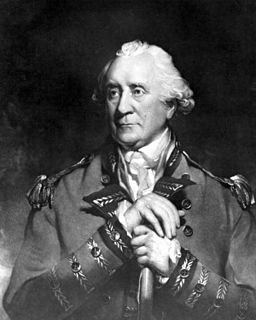Related Research Articles

The American Revolutionary War (1775–1783), also known as the American War of Independence or the Revolutionary War, was initiated by delegates from the thirteen American colonies in Congress against Great Britain over their objection to Parliament's taxation policies and lack of colonial representation. From their founding in the 1600s, the colonies were largely left to govern themselves. The cost of victory in the 1754 to 1763 French and Indian War and 1756 to 1763 Seven Years' War left the British government deeply in debt; attempts to have the colonies pay for their own defense were vigorously resisted. The Stamp Act and Townshend Acts provoked colonial opposition and unrest, leading to the 1770 Boston Massacre and 1773 Boston Tea Party. When Parliament imposed the Intolerable Acts upon Massachusetts, twelve colonies sent delegates to the First Continental Congress to draft a Petition to the King and organize a boycott of British goods.

The 1779 Sullivan Expedition, also known as the Sullivan-Clinton Expedition, or Sullivan Campaign was an extended systematic military campaign during the American Revolutionary War against Loyalists ("Tories") and the four Nations of the Haudenosaunee which had sided with the British. It has been described by some historians as a genocide due to the magnitude and totality of its violence towards and destruction of the Haudenosaunee.

Patrick Tonyn (1725–1804) was a British General who served as the last British governor of East Florida, from 1774 to 1783. His governorship lasted the span of the American Revolution. East Florida was a Loyalist colony during the war.
The Battle of Alligator Bridge took place on June 30, 1778, and was the only major engagement in an unsuccessful campaign to conquer British East Florida during the American Revolutionary War. A detachment of Georgia militiamen under the command of General James Screven chased Thomas Brown's Loyalist company into a large position of British regulars established by British Major Mark Prevost and were turned back.

The Battle of Wyoming was an encounter during the American Revolutionary War between American Patriots and Loyalists accompanied by Iroquois raiders which took place in the Wyoming Valley of Pennsylvania on July 3, 1778, in Exeter and Wyoming, Pennsylvania. More than 300 Patriots were killed in the battle.

The siege of Savannah or the Second Battle of Savannah was an encounter of the American Revolutionary War (1775-1783), in 1779. The year before, the city of Savannah, Georgia, had been captured by a British expeditionary corps under Lieutenant-Colonel Archibald Campbell. The siege itself consisted of a joint Franco-American attempt to retake Savannah, from September 16 to October 18, 1779. On October 9 a major assault against the British siege works failed. During the attack, Polish nobleman Count Casimir Pulaski, leading the combined cavalry forces on the American side, was mortally wounded. With the failure of the joint attack, the siege was abandoned, and the British remained in control of Savannah until July 1782, near the end of the war.

The Western theater of the American Revolutionary War (1775–1783) was the area of conflict west of the Appalachian Mountains, the region which became the Northwest Territory of the United States as well as the states of Kentucky, Tennessee, and Missouri. The western war was fought primarily between American Indians with their British allies in Detroit, and American settlers south and east of the Ohio River.

Samuel Elbert was an American merchant, soldier, and politician from Savannah, Georgia.

Pennsylvania was the site of key events and places related to the American Revolution. The state, and especially the city of Philadelphia, played a critical role in the American Revolution.
The Battle of Thomas Creek, or the Thomas Creek Massacre, was an ambush of a small force of Georgia militia cavalry by a mixed force of British Army, Loyalist militia, and Indians near the mouth of Thomas Creek in northern East Florida. The encounter was the only major engagement in the second of three failed attempts by American forces to invade East Florida in the early years of the American Revolutionary War.
Sawpit Bluff was a small settlement in East Florida during the American Revolutionary War, on the site of a plantation at the mouth of Sawpit Creek where it discharges into Nassau Sound opposite the south end of Amelia Island. It was the location of a proposed rendezvous between mounted militia from Sunbury, Georgia and Continental troops under the command of Lt. Col. Samuel Elbert during the second invasion of Florida in May 1777.
Thomas "Burnfoot" Brown was a British Loyalist during the American Revolution. Intending to become a quiet colonial landowner, he lived, instead, a turbulent and combative career. During the American Revolutionary War he played a key role for the Loyalist cause in the Province of Georgia as a Lt. Col in the King's Carolina Rangers. Following the overthrow of British rule and the Patriot victory in the Revolution, Brown was exiled first to British East Florida, and later to St. Vincent's Island in the Caribbean.
The Province of Georgia was a significant battleground in the American Revolution. Its population was at first divided about exactly how to respond to revolutionary activities and heightened tensions in other provinces. When violence broke out in 1775, radical Patriots took control of the provincial government, and drove many Loyalists out of the province. Georgia also served as the staging ground for several important raids into British-controlled Florida.
Two vessels of the Royal Navy have borne the name HMS Germaine or Germain, in honour of Lord Germain:

Fort San Carlos was a military structure built in 1816 to defend the Spanish colonial town of Fernandina, Florida, now called Old Town, which occupied a peninsula on the northern end of Amelia Island. The fort, a lunette fortification, stood on the southwest side of the town next to the harbor, on a bluff overlooking the Amelia River. It was made of wood and earthworks, backed with a wooden palisade on the east side, and armed with an eight or ten gun battery. Two blockhouses protected access by land on the south, while the village was surrounded with military pickets. An 1821 map of Fernandina shows that the street plan, laid out in 1811 in a grid pattern by the newly appointed Surveyor General of Spanish East Florida, George J. F. Clarke, today preserves nearly the same layout as that of 1821. The fort occupied the area bounded by the streets Calle de Estrada, Calle de White, and Calle de Someruelos. The structure itself has disappeared and only traces remain in what is now Fernandina Plaza Historic State Park.

Fort Morris is an earthen works fort in Liberty County, Georgia, in the United States. The fort is on a bend in the Medway River and played an important role in the protection of southeast Georgia throughout various conflicts beginning in 1741 and ending in 1865 at the conclusion of the American Civil War, including the French and Indian and American Revolutionary Wars and War of 1812. The historic site is 70 acres (28 ha) in size and sits at an elevation of 23 feet (7.0 m).
William Panton was the head of a group of five Scottish merchants who in 1783 founded the powerful and influential trading firm of Panton, Leslie & Company at St. Augustine, then the capital of British East Florida. They formed a partnership to trade with the Indians of Florida and the Spanish borderlands on the southern frontier of the British colonies. By 1795 the company had established a monopoly on trade with the Indian tribes of what is now the southeastern United States, sanctioned by successive governors of Spanish Florida.

Nova Scotia was heavily involved in the American Revolution. The American Revolution (1776–1783) had a significant impact on shaping Nova Scotia, "the 14th American Colony". At the beginning, there was ambivalence in Nova Scotia over whether the colony should join the Americans in the war against Britain. Largely as a result of American Privateer attacks on Nova Scotia villages, as the war continued, the population of Nova Scotia solidified their support for the British. Nova Scotians were also influenced to remain loyal to Britain by the presence of British military units, judicial prosecution by the Nova Scotia Governors and the efforts of Reverend Henry Alline.
Daniel McGirt, also given as McGirtt or McGirth,, a native of the Camden District in South Carolina, was the leader of an outlaw gang that operated in northern Florida and southern Georgia during the latter 1700s. Mostly uneducated, he made a living as a hunter and trapper until the American Revolutionary War broke out, whereupon he served for a while as a scout for the Continental Army, then switched sides, and became one of the more picturesque minor figures of the war.
The King's Carolina Rangers (KCR) was a loyalist militia regiment active during the American War of Independence. The KCR was comprised of nine infantry companies, of which one was converted into a troop of dragoons in 1782. The unit primarily saw action in the South Carolina and Georgia theatres of the conflict.
References
- Bullen, Ripley P (April 1951). "Fort Tonyn and the Campaign of 1778". The Florida Historical Quarterly. Florida Historical Society. 29 (4): 253–260. JSTOR 30139708.
| | This article about a location in Nassau County, Florida is a stub. You can help Wikipedia by expanding it. |